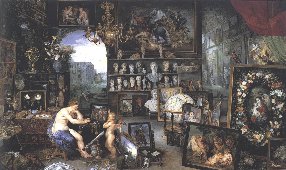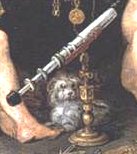Another day, another Voynich theory to add to the list of theories. Today’s one (courtesy of Rolando Hernandez Rivero) proposes that the VMs is written in old Spanish, though with some Latin and English words thrown into the mix. Rolando also asserts that [what he calls] Hand 1 is “scatterbrained” and has many errors, while [what he calls] Hand 2 is a bit more focused. Plants and stars indicate some (unspecified) decoding feature based on the number of leaves or the number of points. The cipher “jumps” many times.
OK, I’ll admit it: though I can read a little Spanish, I’m struggling here. The webpage comprises two sentences, a short 4-line one and a huge 30-line one: it’s basically a sequence of thoughts, a bit like a 5-page PowerPoint presentation converted to plain text. Google Translate and FreeTranslation.com made no more sense of it than I did.
Can anyone translate or summarise this any better?
UPDATE: as the post has mysteriously dropped off the Internet in the last few days, here (courtesy of Google’s cache) is what it originally said:
Este manuscrito esta cifrado con el idioma de HISPANIA, (antiguo idioma que había en España, antes del castellano, de Don Miguel de Cervantes y Saavedra que tomo de los sonidos Árabes mientras dominaban en la mitad de la península Ibérica por 800 a y hasta ahora se suman mas de 4500 palabras).
También tiene latín y algunas palabras inglesas, mas no les podré adelantar mucho ni como esta cifrado porque tiene muchos modelos, hasta ahora lo que contiene, no es de mucho interés no revela mucho en comparación con la mano numero 1 a la de la mano numero 2, y si fueron dos los que contribuyeron a este manuscrito tan controversial y de tanto tiempo sin poderlo descifrar, el manuscrito tiene cosas interesantes de parte de la mano numero 2, que no releva cosas de mayor envergadura, hasta ahora lo que he descifrado no tiene mucha relevancia, solo recetas que aparenta ser de brujos y curanderos, de aquellos tiempos, recetas de plantas que existían bajo el cuidado de nomos y otras entidades o elementales, que por el temor a la inquisición la cifraron y clasificaron, para protegerla, mas estaban en manos de quienes la usaban solamente, la mano numero 1 es incongruente, regada y alocada con muchos fallos y la 2 mas centrada en su conocimiento, ambas muy difícil de descifrar, aparenta tener mas de 4 puños de letras y también es un código muy individual, saltan muchas veces de código, (imposibilita avanzar), la carta astral significa simbología de días y noches, no son meses, cubriendo 13 horas, el sol esta pintado como centro y luna a la vez, esto esta en el código privado, aun sin descifrar, (nueve), las estrellas y los dibujos son números también y guía para los códigos que encierran, hasta sus hojas y puntas de estrellas dicen la cantidad que necesitan saber, al igual que las ninfas, flores y puntas de tallos, esas palabras son trocadas como en el sistema de comunicación, nunca podrán hacer una palabra de ellas, hay varias letras que no se utilizan porque estaban catalogadas como de mala suerte o divisorias, por poner un ejemplo la b, (aparenta que existiera otro código troking y que allí si se usaran estas letras camufladas), las que señalaran el 11, numero intocable, mas si se usaba el 13 normalmente, también atrás he pintado las sombras que existen y hay un dibujo de apariencia de nomo o como se vestía Robin el de la manzana y la flecha, y ataras hay como un bosque y adelante aparecen como si fueran animales y bichos de apariencia raros, esto es por ahora para ayudar a los que están queriendo descifrar, el manuscrito voynich.
UPDATE #2: Enrique Joven (whose forthcoming Voynich novel “The Castle of the Stars” I eagerly await) reassures me that this does indeed make little or no sense at all. So now you know!
UPDATE #3: Dana Scott kindly offers up the following translation (somewhat modified to make it more closely approximate intelligibility) – however, he would gladly welcome suggestions as to what the importance/meaning of “11” and “13” are in the final section.
This manuscript is inscribed in the language of SPAIN, (an ancient tongue that existed in Spain, before Castillian, the language of Sir Michael of Cervantes and Saavedra that drew its phonetics from Arabic at a time when it covered the entire middle peninsula of the Iberian peninsula, around 800 AD, and which today has risen to more than 4500 words. It also contains Latin and some English words, what more I do not have much insight to discern. Nor do I know how this manuscript is inscribed, because it has many forms. Until now what it contains, is not of much interest. Nor does it reveal much when comparing the hand of the first scribe to that of the second scribe. And if there were two scribes who contributed to this controversial manuscript, which for such a long time has remained untranslated, the manuscript contains curious entries on the part of the second scribe, that do not reveal items of major importance. Until now that which I have deciphered does not contain much that seems of interest, only recipes that appear to be for the witches and physicians of those times, recipes of plants that existed under the care of gnomes and other entities or elements, that for the fear of the inquisition it was enciphered and classified, to protect it. What’s more, these secrets were only concealed in the hands of those who used them.
The first scribe is incongruent, rigid and imprecise with many mistakes. The second scribe is more centered in his understanding. Both hands are very difficult to decipher, apparently have more than 4 points of letters and also are very individual (unique) codifiers, which often seem to jump out many timesfrom the codex, (which makes it impossible for us to gain further insight into the manuscript).
The astral text signifies the symbology of days and nights (they are not months) covering 13 hours. The sun is painted at the center of the folio, as is the moon at times. This is in the private codex, though without decipherment, (nine). The stars and the drawings are numbers also, and a guide for the codices that enclose it. Even its leaves and the points of stars indicate the quantity that they need to know. Equally, the nymphs, the flowers, and other points of detail, are words etched in the system of communication. I could never make out a single word of them.
There are various letters that are not used because they are catalogues, such as of bad luck or spells, to put in for example the b. It appears that there exits another codex extant and that there is where it did use these camouflaged letters.
Those that were shown the 11 untouchable numbers would have more if 13 were used normally (unclear sentence; may reference different set of numbers, folios, or codexes?).
Also, in the background (where?), I find painted shadows that exist, and there is a drawing that appears to be a gnome, or how Robin dressed him of the apple and the arrow (William Tell?). In the background there is what appears to be a bosque and in the front it appears as if there were animals and vermin rare in appearance. This is what I have for now to help those who are wanting to decipher, the Voynich manuscript.



 One small feature I’ve been mulling over is the “starred paragraphs” in Quire 20, the final gathering in the VMs (the one which famously ends with the “michiton oladabas” page). I posted about this section not long ago, discussing Vladimir Sazonov’s suggestion that it might originally have formed some kind of
One small feature I’ve been mulling over is the “starred paragraphs” in Quire 20, the final gathering in the VMs (the one which famously ends with the “michiton oladabas” page). I posted about this section not long ago, discussing Vladimir Sazonov’s suggestion that it might originally have formed some kind of